#15 April 1912
Text
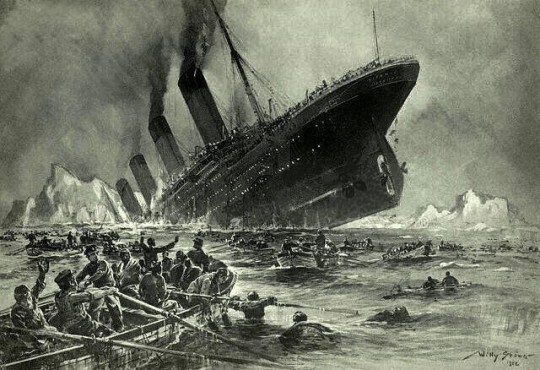
An artist's rendering of the most famous shipwreck in history - 1912
#RMS Titanic#White Star Line#iceberg#lifeboats#1500 lost#Atlantic Ocean#15 April 1912#On this day#In memoriam#UK
26 notes
·
View notes
Text
Titanic: First ever full-sized scans reveal wreck as never seen before

Titanic departing Southampton on 10 April 1912
By Rebecca Morelle and Alison Francis
BBC News Climate and Science
17 May 2023
The world's most famous shipwreck has been revealed as never seen before.
The first full-sized digital scan of the Titanic, which lies 3,800m (12,500ft) down in the Atlantic, has been created using deep-sea mapping.
It provides a unique 3D view of the entire ship, enabling it to be seen as if the water has been drained away.
The hope is that this will shed new light on exactly what happened to the liner, which sank on 15 April 1912.
More than 1,500 people died when the ship struck an iceberg on its maiden voyage from Southampton to New York.
"There are still questions, basic questions, that need to be answered about the ship," Parks Stephenson, a Titanic analyst, told BBC News.
He said the model was "one of the first major steps to driving the Titanic story towards evidence-based research - and not speculation."
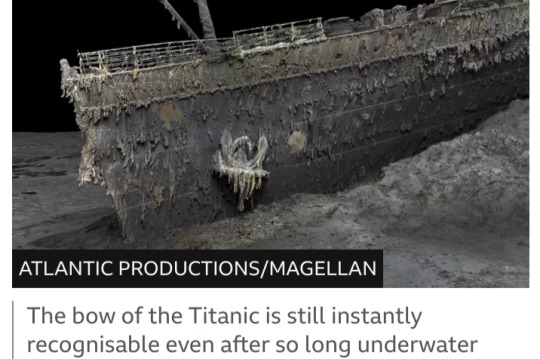
The Titanic has been extensively explored since the wreck was discovered in 1985.
But it's so huge that in the gloom of the deep, cameras can only ever show us tantalizing snapshots of the decaying ship - never the whole thing.
The new scan captures the wreck in its entirety, revealing a complete view of the Titanic.
It lies in two parts, with the bow and the stern separated by about 800m (2,600ft). A huge debris field surrounds the broken vessel.
The scan was carried out in summer 2022 by Magellan Ltd, a deep-sea mapping company, and Atlantic Productions, who are making a documentary about the project.
Submersibles, remotely controlled by a team on board a specialist ship, spent more than 200 hours surveying the length and breadth of the wreck.
They took more than 700,000 images from every angle, creating an exact 3D reconstruction.
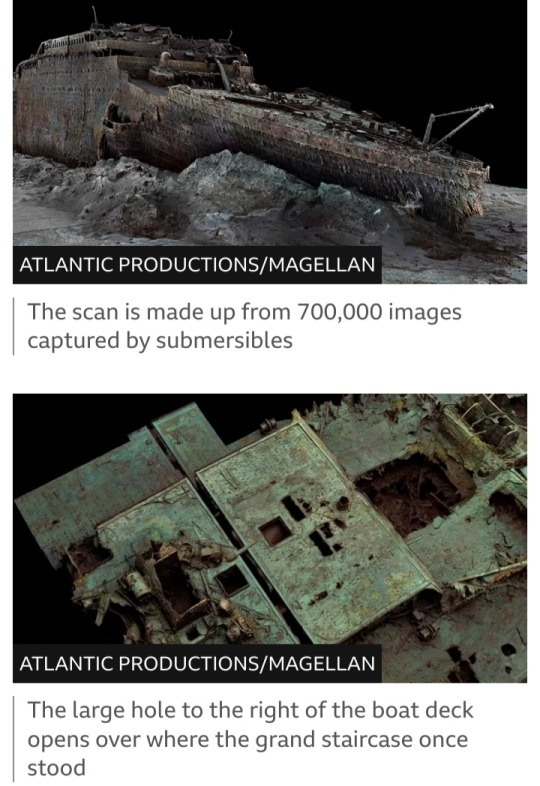
Magellan's Gerhard Seiffert, who led the planning for the expedition, said it was the largest underwater scanning project he'd ever undertaken.
"The depth of it, almost 4,000m, represents a challenge, and you have currents at the site, too - and we're not allowed to touch anything so as not to damage the wreck," he explained.
"And the other challenge is that you have to map every square centimetre - even uninteresting parts, like on the debris field you have to map mud, but you need this to fill in between all these interesting objects."
The scan shows both the scale of the ship, as well as some minute details, such as the serial number on one of the propellers.

The bow, now covered in stalactites of rust, is still instantly recognisable even 100 years after the ship was lost.
Sitting on top is the boat deck, where a gaping hole provides a glimpse into a void where the grand staircase once stood.
The stern though, is a chaotic mess of metal. This part of the ship collapsed as it corkscrewed into the sea floor.
In the surrounding debris field, items are scattered, including ornate metalwork from the ship, statues and unopened champagne bottles.
There are also personal possessions, including dozens of shoes resting on the sediment.

Parks Stephenson, who has studied the Titanic for many years, said he was "blown away" when he first saw the scans.
"It allows you to see the wreck as you can never see it from a submersible, and you can see the wreck in its entirety. You can see it in context and perspective. And what it's showing you now is the true state of the wreck."
He said that studying the scans could offer new insight into what happened to the Titanic on that fateful night of 1912.
"We really don't understand the character of the collision with the iceberg. We don't even know if she hit it along the starboard side, as is shown in all the movies - she might have grounded on the iceberg," he explained.
Studying the stern, he added, could reveal the mechanics of how the ship struck the sea floor.

The sea is taking its toll on the wreck, microbes are eating away at it and parts are disintegrating.
Historians are well aware that time is running out to fully understand the maritime disaster.
But the scan now freezes the wreck in time and will allow experts to pore over every tiny detail.
The hope is that the Titanic may yet give up its secrets.
#Titanic#shipwreck#deep-sea mapping#RMS Titanic#Magellan Ltd#Atlantic Productions#Gerhard Seiffert#Parks Stephenson#White Star Line#North Atlantic Ocean#15 April 1912#iceberg#digital scan#3D reconstruction
21 notes
·
View notes
Text




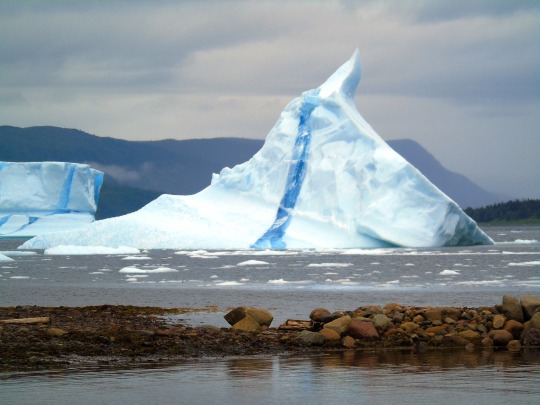
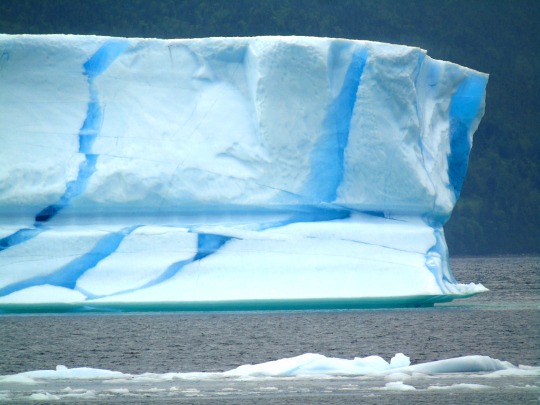

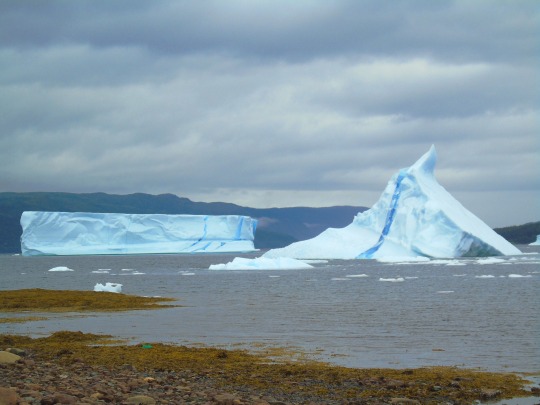

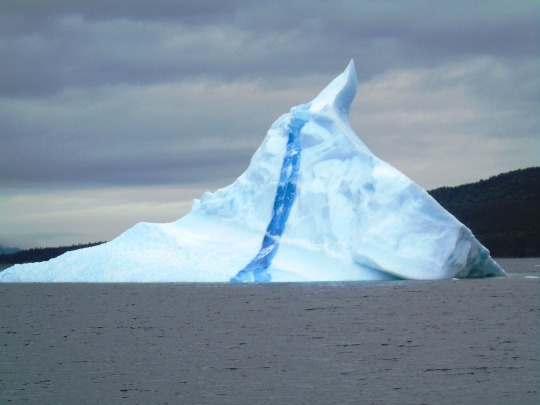

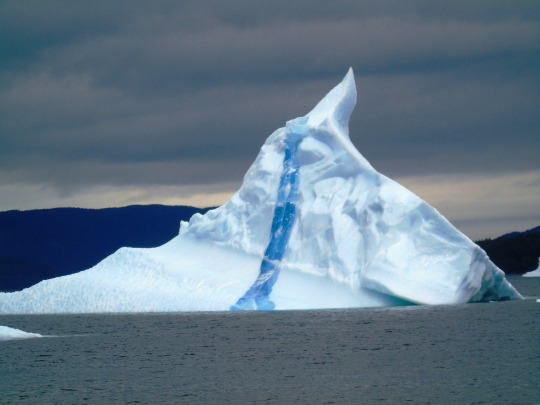

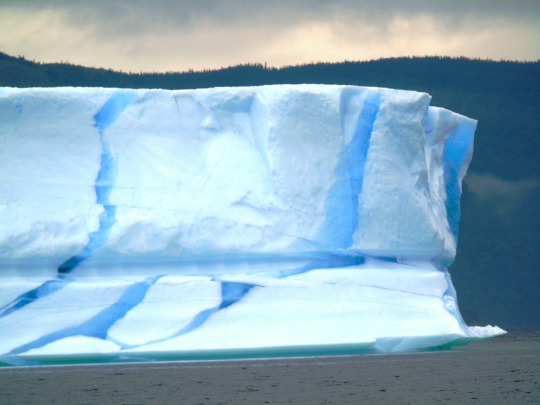
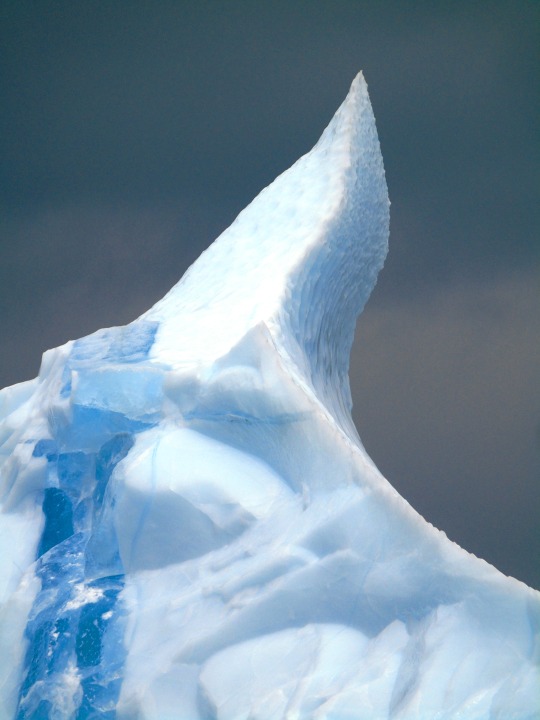
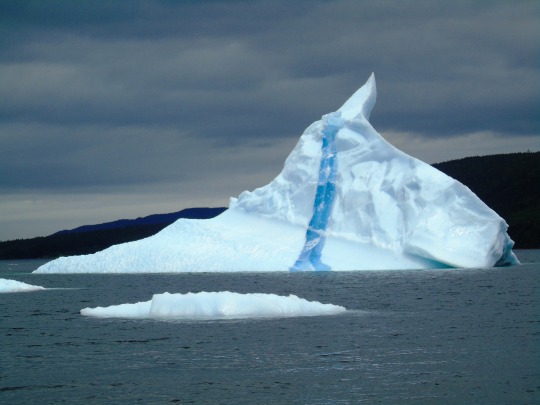

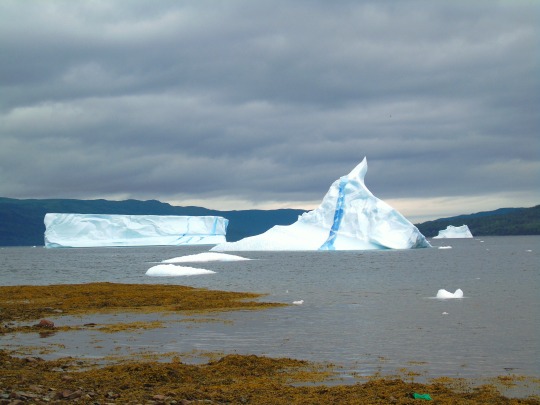
The British passenger liner RMS Titanic sank in the North Atlantic at 2:20 a.m., two hours and forty minutes after hitting an iceberg, on April 15, 1912. Only 710 of 2,224 passengers and crew on board survived.
#RMS Titanic#iceberg#15 April 1912#anniversary#history#tragedy#travel#very impressive#huge#Green Bay#King's Point#Atlantic Ocean#vacation#Newfoundland and Labrador#Newfoundland#summer 2015#tourist attraction#dark clouds#storm clouds#blue ice#landscape#countryside#beach#coast#nature#seascape#original photography#landmark#Canada#sank
1 note
·
View note
Text
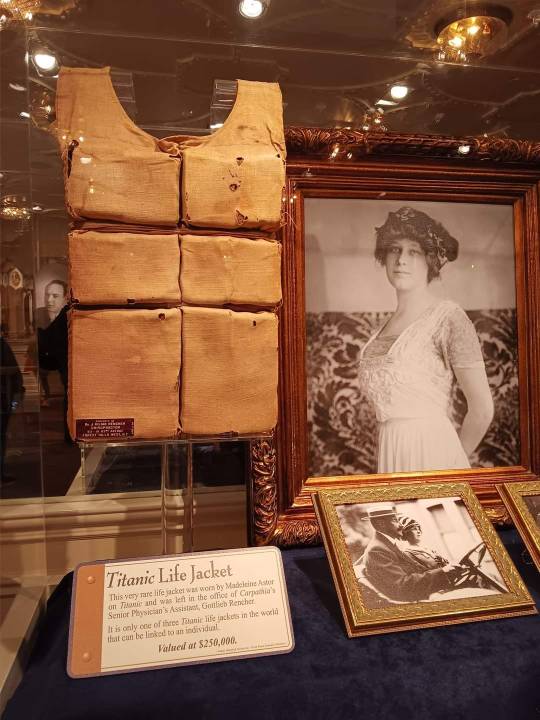
Madeline Astor's life vest at Titanic museum in Pigeon Forge
36 notes
·
View notes
Text
Watched Titanic 1997
I am sobbing
Over both the true story and the made-up love story
Somebody send help
And tissues
And ice cream
And James Cameron so I can hit him with a bat
#titanic#1997#titanic 1997#jack dawson#rose dewitt bukater#rose dawson#jack and rose#rms titanic#1912#april 15 1912
23 notes
·
View notes
Text



Perchè quando si presentano i guai un vero Capitano non abbandona mai la sua nave, ma se può, lo fa per ultimo. Il Capitano Edward Smith invece morì con la sua nave.
25 notes
·
View notes
Text

#collage artist#collage art#digital collage#collage#mixed media#art journal#artists on tumblr#artwork#art#titanic#1912#april#april 15#edward smith#sea#art work#artists of tumblr#captain edward smith#leonardo dicaprio#black and white#blue#ocean#ship
6 notes
·
View notes
Text





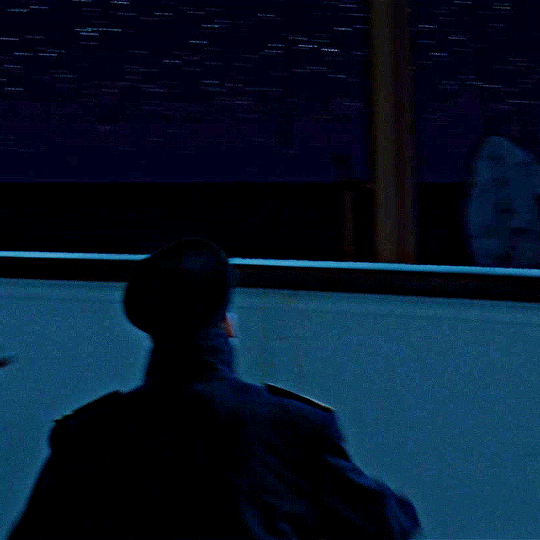


APRIL 14th 1912 - TITANIC HITS THE ICEBURG
During the course of the day, the Titanic was sent numerous warnings about the iceberg from other vessels, the first warning sent from the Caronia at 9.00am. A total of five warnings were sent . On the same day the first scheduled lifeboat drill was cancelled by Captain Edward Smith without explanation - meaning that the crew were unrehearsed in what to do when the time came. At 5.50pm Titanic changes course from south west to due west. This was originally planned to occur at 5.30pm but was delayed to allow Titanic to travel further south in an attempt to avoid the ice region reported by the Baltic. This change should have directed the Titanic into an area of the gulf stream that would be free of icebergs; in any normal year this would be the case, but 1912 was not a normal year for ice – cold water had pushed the warm gulf stream further south – and the change in direction actually put the ship on a collision course with the iceberg.
At 9.40pm Senior Wireless Operator Jack Phillips receives the fifth and final ice warning, from the SS Mesaba, warning of a “great number” of large icebergs and field ice just 15 miles ahead of the Titanic. Because the message was not prefixed with MSG – the signifier that the communique was intended for the captain – Phillips treated it as non-urgent, failed to pass the message on, and returned to the busy task of sending passengers’ personal telegrams.
At 11.39pm The iceberg lies just 1,000 yards ahead, but the moonless conditions mean the lookouts cannot see it. 30 seconds later and Frederick Fleet spots the iceberg, calling the bridge to proclaim, “Iceberg, right ahead!”, but it is too late to avoid a collision. At 11.40pm Titanic hits the iceberg, hitting the starboard bow. Many passengers and crew sleep through the collision whilst many others – including lookout man Fleet – assume the ship has survived a glancing blow and is undamaged.
#titanicedit#titanic#filmcentral#filmedit#filmgif#televisiongifs#cinemapix#cinemaspam#cinematv#userfilm#userstream#useroptional#usertelevision#userentertainments#gifshistorial#mine#gif
549 notes
·
View notes
Text

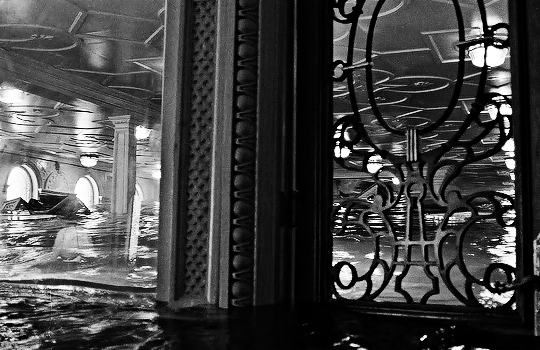


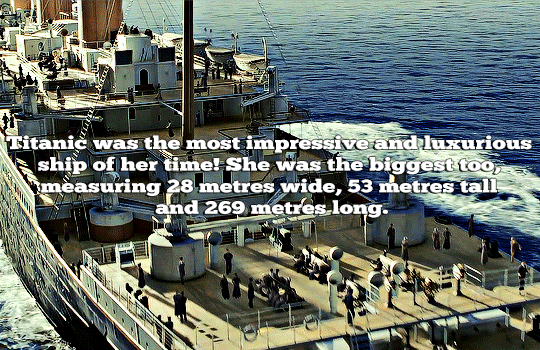

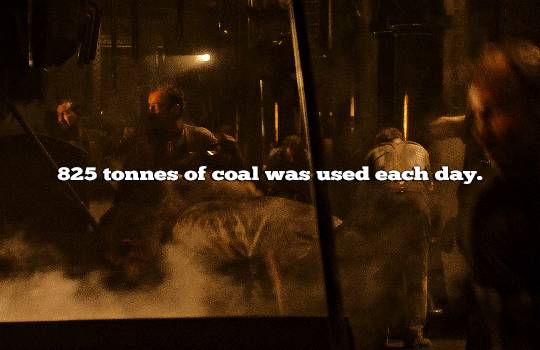

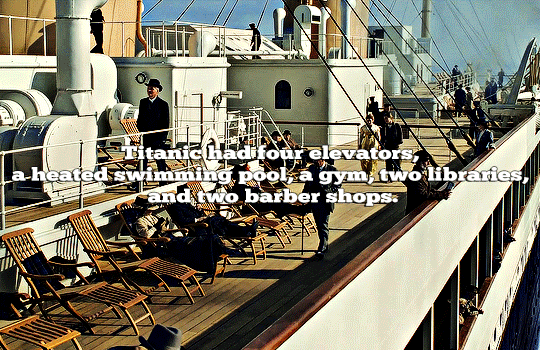










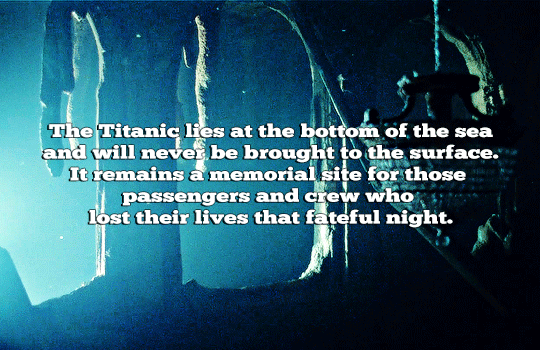
"C.Q.D. Help! Help! We are sinking."
The RMS Titanic sank in the early morning hours of 15 April 1912 in the North Atlantic Ocean, four days into her maiden voyage from Southampton to New York City
14th-15th April 1912
At 11:40 pm on 14 April, lookout Frederick Fleet spotted an iceberg immediately ahead of Titanic and alerted the bridge. First Officer William Murdoch ordered the ship to be steered around the obstacle and the engines to be reversed, but it was too late; the starboard side of Titanic struck the iceberg, creating a series of holes below the waterline.
The hull was not punctured by the iceberg, but rather dented such that the hull's seams buckled and separated, allowing water to rush in. Five of the ship's watertight compartments were breached. It soon became clear that the ship was doomed, as she could not survive more than four compartments being flooded.
Titanic began sinking bow-first, with water spilling from compartment to compartment as her angle in the water became steeper. Between 2:10 and 2:15 a.m., a little over two and a half hours after Titanic struck the iceberg, her rate of sinking suddenly increased as the boat deck dipped underwater, and the sea poured in through open hatches and grates. As her unsupported stern rose out of the water, exposing the propellers, the ship broke in two main pieces between the second and third funnels, due to the immense forces on the keel. With the bow underwater, and air trapped in the stern, the stern remained afloat and buoyant for a few minutes longer, rising to a nearly vertical angle with hundreds of people still clinging to it, before foundering at 2:20 am.
#titanic#the titanic#filmtvdaily#filmedit#filmdaily#filmgif#tvandfilmdaily#dailyflicks#movieedit#perioddramaedit#periodedit#periodramagif#userstream#userbbelcher#useroptional#tvfilmcentral#moviegifs#cinemaspam#mine
618 notes
·
View notes
Text

Tragic news of Titanic's sinking reaches London on this day in 1912
#RMS Titanic#White Star Line#Oceanic House#Old London#vintage photo#colourised#Evening News#UK#15 April 1912
76 notes
·
View notes
Text
No matter which one wins, everybody loses!
#I got polls this is how I am celebrating#disasters#the great fire of rome#mount vesuvius#pompeii#the black death#the plague#the donner party#cannabalism#earthquake#fire#titanic#the great molasses flood of 1919#boston molasses flood#hindenburg#the great smog#chernobyl
2K notes
·
View notes
Text
so as a former employee of RMS Titanic Inc, I have some thoughts I need to get out about this whole current situation, or I will literally explode.
for context, I worked for RMST Inc. for a year and a half as a tour guide and artifact specialist. The company owns the salvage rights to the wreck site, and partners with Oceangate and other companies to retrieve artifacts. the artifacts are used for educational purposes only, in the museum that I worked at, although they weren’t above selling little bits of coal from the Titanic in stupid little tchotchkes like snowglobes and hourglasses.
i dedicated so much of my life and passion to that company and that museum and was treated like absolute dirt lol. and I didn’t even get the worst of it, I had friends and coworkers whose safety and wellbeing was consistently disregarded for the sake of profit, fighting desperately for corporate to stop pretending to care about the legacy of Titanic when all they really cared about was making money
so despite my initial shock at reading about what was going on with the missing submersible, I can’t say I’m surprised. This is what fucking happens when you cut corners and put profit over everything else. If only there was some big historical event that we could look to that would show us just exactly how dangerous that can be... oh wait.
Jack Thayer, who was 17 when he survived Titanic, said that “the world woke up on April 15, 1912″, which pretty much sums up how SURE people were in 1912 that they would never make those same mistakes again. They realized had gotten complacent and swore things would be different. They enacted safety laws, pointed fingers at survivors, created conspiracy theories to try to explain what happened, all out of fear of it happening again. And yet, history always repeats itself
and now people are fucking OBSESSED with the Titanic, they find it fascinating, they won’t fucking leave it alone, and the company I worked for, and Oceangate, and others, capitalize on that because they’re greedy and want to make money off of it. all they care about is how to profit off of it. they PRETEND to care about Titanic but they don’t. They never did.
I also actually have a personal connection to one of the five members of the team in the submersible. I met P.H. Nargeolet at the event our museum did commemorating the 110th anniversary of the sinking, I spoke to him and heard firsthand some of his accounts of dives to the wreck site, I even took a picture with him. He cared, he cared so much about Titanic and its legacy, and so do I and so did so many of my friends I worked with. The company we worked for took advantage of our caring, it took advantage of how passionate we were about it in order to line its executives’ fucking pocket
I’m horrified, I’m devastated, I’m vindicated.
on the one hand, I hope this ruins them. i want to watch the company die. there’s a satisfaction in that. but the shitty thing is how much suffering has to happen for things to change. i just wish good people didn’t have to die to make change happen. I wish people cared first, before tragedy strikes. I wish our world wasn’t so fucked up and shit like this didn’t happen. But it did. And it does. And money won’t save any of those people any more than it saved John Jacob Astor or Benjamin Guggenheim, or any of the other rich greedy assholes who died on Titanic. I’m not celebrating their deaths. But I won’t ever forget who suffers the most. The coal trimmers and the stewards and the minimum wage guest service associates at the museum I worked at.
I’m glad I don’t work there anymore. But some of my best friends still do. And I don’t want them to suffer more because of this. All I can hope is that it enacts meaningful change that actually lasts. But I know that’s just wishful thinking.
#win rambles#this is very convoluted and not really... idk how much sense it makes i just had to get thoughts out#i don' thave a witty conclusion or a message or anything like that#i just want people to know how shitty our company was and i want you to know how much i loved that job and how much i cared#and how much people in the titanic community do care#i'm just tired of seeing posts and memes about it from poeple who don't know what they're talking about#the titanic community is full of shitty bigoted white men and people who fucked me over bc i'm trans#and fucked over my queer nonwhite neurodivergent disabled friends#but me and my friends are in the community too whether they like it or not and we care and WE matter#titanic#rms titanic
256 notes
·
View notes
Text

Live A Little | A Worth It AU | Ralph Penbury x You
That's right kids, The Mystery Series is a Worth It AU! The players are the same, but the setting is the RMS Titanic in April 1912.
You don't have to have read Worth It to understand Live A Little, but I've sprinkled it with cameos and Easter eggs from the original series.
The biggest character difference is that You are now an American. Congrats! "Home" is a vague place that's probably somewhere in the northeast. You're still a twenty-something who loves Dad, disappoints Mom, and is bored by a boy named Donald.
There will be a happy ending. None of this "I'll never let go!" and then immediately letting go and watching your boy sink. Not on my watch.
Chapters will come out on the day they're set, and vary in length. Some days are more exciting than others!
I've been researching and writing this on and off for about a year. I'm sure you've all seen the 1997 movie, and images from that will be what I use for most of my headers. I'll also be using the occasional image from Titanic: Honor and Glory.
Bonus: Want to see the cabins You and Ralph are occupying?

CHAPTERS:
December 1911
April 10, 1912
April 11, 1912
April 12, 1912
April 13, 1912
April 14, 1912
April 15, 1912
April 16, 1912
April 17, 1912
April 18, 1912
April 19, 1912

#masterlist#writings of despair#ralphtanic#ralph penbury#ralph penbury x you#ralph penbury x reader#ralph timewasters
39 notes
·
View notes
Text
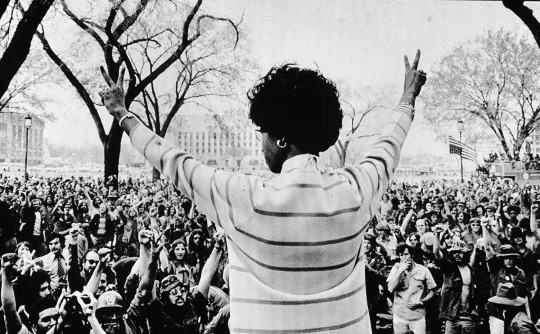
Black women have made important contributions to the United States throughout its history. However, they are not always recognized for their efforts, with some remaining anonymous and others becoming famous for their achievements. In the face of gender and racial bias, Black women have broken barriers, challenged the status quo, and fought for equal rights for all. The accomplishments of Black female historical figures in politics, science, the arts, and more continue to impact society.
Marian Anderson (Feb. 27, 1897–April 8, 1993)

Underwood Archives / Getty Images
Contralto Marian Anderson is considered one of the most important singers of the 20th century. Known for her impressive three-octave vocal range, she performed widely in the U.S. and Europe, beginning in the 1920s. She was invited to perform at the White House for President Franklin Roosevelt and First Lady Eleanor Roosevelt in 1936, the first African American so honored. Three years later, after the Daughters of the American Revolution refused to allow Anderson to sing at a Washington, D.C. gathering, the Roosevelts invited her to perform on the steps of the Lincon Memorial.
Anderson continued to sing professionally until the 1960s when she became involved in politics and civil rights issues. Among her many honors, Anderson received the Presidential Medal of Freedom in 1963 and a Grammy Lifetime Achievement Award in 1991.
Mary McLeod Bethune (July 10, 1875–May 18, 1955)
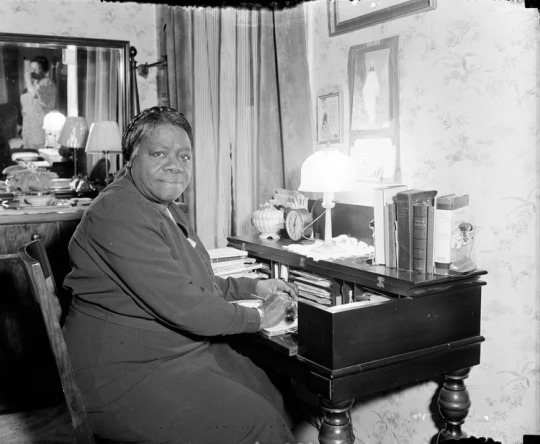
PhotoQuest / Getty Images
Mary McLeod Bethune was an African American educator and civil rights leader best known for her work co-founding the Bethune-Cookman University in Florida. Born into a sharecropping family in South Carolina, the young Bethune had a zest for learning from her earliest days. After stints teaching in Georgia, she and her husband moved to Florida and eventually settled in Jacksonville. There, she founded the Daytona Normal and Industrial Institute in 1904 to provide education for Black girls. It merged with the Cookman Institute for Men in 1923, and Bethune served as president for the next two decades.
A passionate philanthropist, Bethune also led civil rights organizations and advised Presidents Calvin Coolidge, Herbert Hoover, and Franklin Roosevelt on African American issues. In addition, President Harry Truman invited her to attend the founding convention of the United Nations; she was the only African American delegate to attend.
Shirley Chisholm (Nov. 30, 1924–Jan. 1, 2005)
Don Hogan Charles / Getty Images
Shirley Chisholm is best known for her 1972 bid to win the Democratic presidential nomination; she was the first Black woman to make this attempt in a major political party. However, she had been active in state and national politics for more than a decade and had represented parts of Brooklyn in the New York State Assembly from 1965 to 1968. She became the first Black woman to serve in Congress in 1968. During her tenure, she co-founded the Congressional Black Caucus. Chisholm left Washington in 1983 and devoted the rest of her life to civil rights and women's issues.
Althea Gibson (Aug. 25, 1927–Sept. 28, 2003)

Reg Speller / Getty Images
Althea Gibson started playing tennis as a child in New York City, winning her first tennis tournament at age 15. She dominated the American Tennis Association circuit, reserved for Black players, for more than a decade. In 1950, Gibson broke the tennis color barrier at Forest Hills Country Club (site of the U.S. Open); the following year, she became the first African American to play at Wimbledon in Great Britain. Gibson continued to excel at the sport, winning both amateur and professional titles through the early 1960s.
Dorothy Height (March 24, 1912–April 20, 2010)

Chip Somodevilla / Getty Images
Dorothy Height has been described as the godmother of the women's movement because of her work for gender equality. For four decades, she led the National Council of Negro Women (NCNW )and was a leading figure in the 1963 March on Washington. Height began her career as an educator in New York City, where her work caught the attention of Eleanor Roosevelt. Beginning in 1957, she led the NCNW and also advised the Young Women's Christian Association (YWCA). She received the Presidential Medal of Freedom in 1994.
Rosa Parks (Feb. 4, 1913–Oct. 24, 2005)
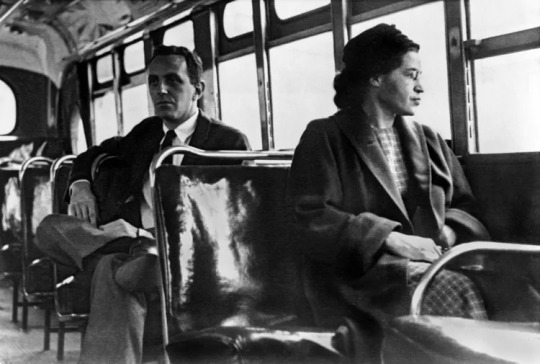
Underwood Archives / Getty Images
Rosa Parks became active in the Alabama civil rights movement after marrying activist Raymond Parks in 1932. She joined the Montgomery, Alabama, chapter of the National Association for the Advancement of Colored People (NAACP) in 1943 and was involved in much of the planning that went into the famous bus boycott that began the following decade. Parks is best known for her December 1, 1955, arrest for refusing to give up her bus seat to a White rider. That incident sparked the 381-day Montgomery Bus Boycott, which eventually desegregated that city's public transit. Parks and her family moved to Detroit in 1957, and she remained active in civil rights until her death.
Augusta Savage (Feb. 29, 1892–March 26, 1962)
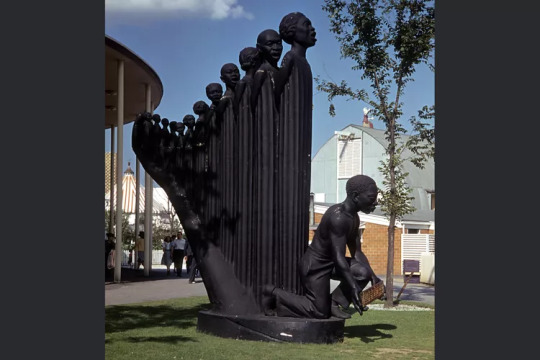
Archive Photos / Sherman Oaks Antique Mall / Getty Images
Augusta Savage displayed an artistic aptitude from her youngest days. Encouraged to develop her talent, she enrolled in New York City's Cooper Union to study art. She earned her first commission, a sculpture of civil rights leader W.E.B. Du Bois, from the New York library system in 1921, and several other commissions followed. Despite meager resources, she continued working through the Great Depression, making sculptures of several notable Black people, including Frederick Douglass and W. C. Handy. Her best-known work, "The Harp," was featured at the 1939 World's Fair in New York, but it was destroyed after the fair ended.
Harriet Tubman (1822–March 20, 1913)

Library of Congress
Enslaved from birth in Maryland, Harriet Tubman escaped to freedom in 1849. The year after she arrived in Philadelphia, Tubman returned to Maryland to free her family members. Over the next 12 years, she returned nearly 20 times, helping more than 300 enslaved Black people escape bondage by ushering them along the Underground Railroad. The "railroad" was the nickname for a secret route that enslaved Black people used to flee the South for anti-slavery states in the North and to Canada. During the Civil War, Tubman worked as a nurse, a scout, and a spy for Union forces. After the war, she worked to establish schools for formerly enslaved people in South Carolina. In her later years, Tubman also became involved in women's rights causes.
Phillis Wheatley (May 8, 1753–Dec. 5, 1784)

Culture Club/Hulton Archive/Getty Images
Born in Africa, Phillis Wheatley came to the U.S. at age 8, when she was captured and sold into enslavement. John Wheatley, the Boston man who enslaved her, was impressed by Phillis' intellect and interest in learning, and he and his wife taught her to read and write. The Wheatleys allowed Phillis time to pursue her studies, which led her to develop an interest in poetry writing. A poem she published in 1767 earned her much acclaim. Six years later, her first volume of poems was published in London, and she became known in both the U.S. and the United Kingdom. The Revolutionary War disrupted Wheatley's writing, however, and she was not widely published after it ended.
Charlotte Ray (Jan. 13, 1850–Jan. 4, 1911)
Charlotte Ray has the distinction of being the first African American woman lawyer in the United States and the first woman admitted to the bar in the District of Columbia. Her father, active in New York City's Black community, made sure his young daughter was well educated; she received her law degree from Howard University in 1872 and was admitted to the Washington, D.C., bar shortly afterward. Both her race and gender proved to be obstacles in her professional career, and she eventually became a teacher in New York City instead.
#10 of the Most Important Black Women in U.S. History#Black Women#Black Women Matter#Black Lives Matter#us history
214 notes
·
View notes
Text

Happy birthday, Kim Il-Sung! (April 15, 1912)
Leader of the Democratic People's Republic of Korea from 1948 until his death in 1994, Kim Il-Sung was born to a Presbyterian family in South Heian Province during the period of Japanese rule over Korea. Kim's family was active in struggle against Japanese rule, and in 1926 Kim founded the Down-With-Imperialism Union. He became interested in communism in the early 1930s, and joined the Communist Party of China in 1931, fighting as an anti-Japanese guerilla in northern China for several years. He became a leader to the Koreans involved with the CPC due to his actions in the Minsaengdan incident, an attempted purge of Koreans from the CPC in Manchuria. After the end of World War II, Kim, extremely popular for his leadership in the anti-imperialist struggle, became leader of the socialist government established in the northern half of the Korean peninsula. Under Kim's leadership, healthcare was made a human right and made available to all citizens, land was redistributed, industry was nationalized, and working hours were reduced to eight hours per day. For a considerable amount of time, prior to the destruction of a large portion of the north's infrastructure by American forces in the Korean War, the standard of living in the DPRK was much better than that in the southern Republic of Korea. After the war, Kim undertook efforts to rebuild his country, while also establishing the DPRK on the world stage and charting a middle path through the Sino-Soviet Split. Kim also established the state ideology of the DPRK as juche, a form of Marxism-Leninism applied to the material conditions of the DPRK, emphasizing self-reliance. He died of a sudden heart attack in 1994.
"Socialism is a human ideal, an inevitable course of historical development, and therefore it is perfectly clear that socialism will rise again in the end."
216 notes
·
View notes
Text

The iceberg suspected of having sunk the RMS Titanic. This iceberg was photographed by the chief steward of the liner Prinz Adalbert on the morning of April 15, 1912, just a few miles south of where the “Titanic” went down.
The steward hadn't yet heard about the Titanic. What caught his attention was the smear of red paint along the base of the berg, indication that it had collided with a ship sometime in the previous twelve hours. Other accounts indicated that there were several icebergs in the vicinity where the Titanic collided.

During WWI the SS Prinz Adalbert (not to be confused with the German cruiser SMS Prinz Adalbert) was captured by the British and eventually ended up as Alesia under a French flag. It was sunk off Brittany by a U-boat.
21 notes
·
View notes